If you are anything like me you will have what feels like a million seedlings growing away nicely in your greenhouses or filling windowsills, taking up more and more space by the day.
Sowing seeds is easy enough and they are so small it is easy to get carried away. But a month or so down the track when they start to outgrow their pots and need transplanting you begin to see the magnitude of the situation. I think it will be fair to say most of us have more seedlings than we have garden space!
Now normally when we pack the car to go on a trip somewhere, Hubby the Un-Gardener will say we have too much stuff, to which I reply, ‘make it fit.’ And somehow he does. However, in the garden the ‘make it fit’ philosophy doesn’t work, and we need to adapt it to ‘less is more’ to get the best results at the end.
Plants that are too crowded can fail to thrive and never reach their full potential and you miss out on what could have been a bumper harvest and have to settle for a meagre one, without realising what could have been.
So, what you need to do – if you haven’t already is to measure your garden to find out exactly what space you do have and draw a map.
Then research the plants you are growing and find out how big they get – not just tall, but wide. Find out if they are sprawlers and can they be trained. Find out if they need regular harvesting or maintenance. Are they the kind of crop you can leave to fend for itself until the harvest is ready. Find out as much as you can.
Next is working out where everything needs to go in the garden, so they have the space they need. There is a handy table in the Yates Garden Guide that suggests how many plants you would need from each veggie to feed a family of four which is a great help when planning, so you don’t plant too many of one plant and not enough of another.
As you lay out your design bear in mind:
· Tall crops at the back so they don’t shade the garden
· Corn needs to be in a block to suit its wind pollination needs. At the very least you need 3 x 4 to avoid gappy cobs.
· Sprawling plants can be encouraged to go over the edge of the bed. Young pumpkins and melons can be trained in the direction you want them to go with landscape staples or could be directed up a trellis or tree. Zucchini can be tied to stakes to grow vertically, but it isn’t their natural growth habit so take care tying them to the stake and do it often.
· Plants that need regular attention like peas and tomatoes should be positioned with easy access to a path, whereas beetroot and cabbage can be in a more out of reach spot and left to do their thing.
· Try to leave some gaps for succession planting for things like salad crops, beetroot, and carrots.
· If you are companion planting, they don’t need to be planted right up beside each other so make sure you give both of them the space they need to benefit from the relationship.
· If you don’t have the space – don’t squish things in, extend the garden – there is still plenty of time to do that if you need to, or consider container gardening for the ‘must haves but can’t fits’ or be brave pass your seedlings on to someone else.
It is so tempting to just plonk things in the garden, but some crops get massive, and it is really hard to visualise when planting out tiny seedlings in the middle of an empty garden. Add a tape measure to your planting out tool kit and you will be rewarded with an abundant harvest.
I hope this helps and makes sense.
This week I have been reminded to watch the weather closely. I was all set to Weed n Feed my lawn only to see that for the next week it will be rainy, and I need 2 days of dry for it to work. And the extended forecast looks like it will dip to cold again at the end of next week. So I will have to wait before I sort my lawn out, but when I do I’ll be using https://www.yates.co.nz/products/lawn-care/lawn-weed-control/yates-weed-n-feed-double-action-granular/ because the granular is less of a risk of getting overspray on the garden.
Happy gardening and as always – if you want to get in touch leave a comment below.
Sarah the Gardener : o)










Share
Share this blog on social media